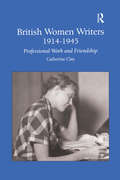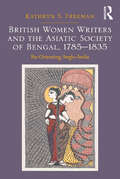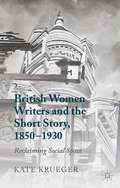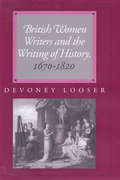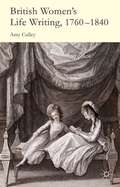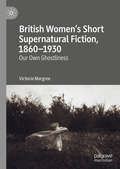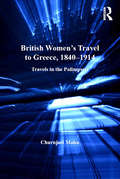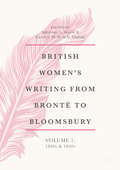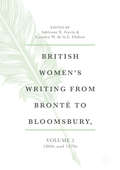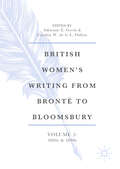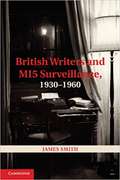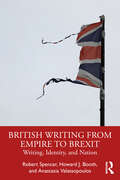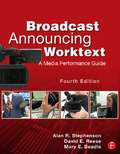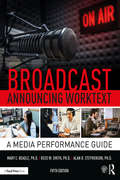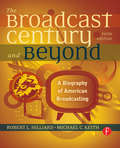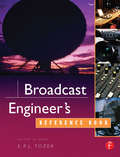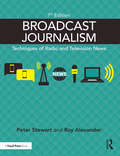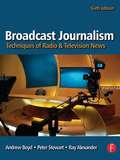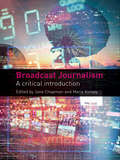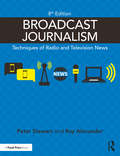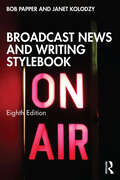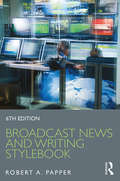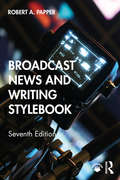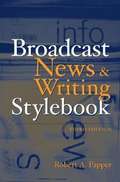- Table View
- List View
British Women Writers 1914-1945: Professional Work and Friendship
by Catherine ClayCatherine Clay's persuasively argued and rigorously documented study examines women's friendships during the period between the two world wars. Building on extensive new archival research, the book's organizing principle is a series of literary-historical case-studies that explore the practices, meanings and effects of friendship within a network of British women writers, who were all loosely connected to the feminist weekly periodical Time and Tide. Clay considers the letters and diaries, as well as fiction, poetry, autobiographies and journalistic writings, of authors such as Vera Brittain, Winifred Holtby, Storm Jameson, Naomi Mitchison, and Stella Benson, to examine women's friendships in relation to two key contexts: the rise of the professional woman writer under the shadow of literary modernism and historic shifts in the cultural recognition of lesbianism crystallized by The Well of Loneliness trial in 1928. While Clay's study presents substantial evidence to support the crucial role close and enduring friendships played in women's professional achievements, it also boldly addresses the limitations and denials of these relationships. Producing 'biographies of friendship' untold in existing author studies, her book also challenges dominant accounts of women's friendships and advances new ways for thinking about women's friendship in contemporary debates.
British Women Writers and the Asiatic Society of Bengal, 1785-1835: Re-Orienting Anglo-India
by Kathryn S. FreemanIn her study of newly recovered works by British women, Kathryn Freeman traces the literary relationship between women writers and the Asiatic Society of Bengal, otherwise known as the Orientalists. Distinct from their male counterparts of the Romantic period, who tended to mirror the Orientalist distortions of India, women writers like Phebe Gibbes, Elizabeth Hamilton, Sydney Owenson, Mariana Starke, Eliza Fay, Anna Jones, and Maria Jane Jewsbury interrogated these distortions from the foundation of gender. Freeman takes a three-pronged approach, arguing first that in spite of their marked differences, female authors shared a common resistance to the Orientalists’ intellectual genealogy that allowed them to represent Vedic non-dualism as an alternative subjectivity to the masculine model of European materialist philosophy. She also examines the relationship between gender and epistemology, showing that women’s texts not only shift authority to a feminized subjectivity, but also challenge the recurring Orientalist denigration of Hindu masculinity as effeminate. Finally, Freeman contrasts the shared concern about miscegenation between Orientalists and women writers, contending that the first group betrays anxiety about intermarriage between East Indian Company men and indigenous women while the varying portrayals of intermarriage by women show them poised to dissolve the racial and social boundaries. Her study invites us to rethink the Romantic paradigm of canonical writers as replicators of Orientalists’ cultural imperialism in favor of a more complicated stance that accommodates the differences between male and female authors with respect to India.
British Women Writers and the Short Story, 1850-1930
by Kate KruegerThis book addresses a critically neglected genre used by women writers from Gaskell to Woolf to complicate Victorian and modernist notions of gender and social space. Their innovative short stories ask Britons to reconsider where women could live, how they could be identified, and whether they could be contained.
British Women Writers and the Writing of History, 1670-1820
by Devoney LooserChosen by Choice Magazine as an Outstanding Academic TitleUntil recently, history writing has been understood as a male enclave from which women were restricted, particularly prior to the nineteenth century. The first book to look at British women writers and their contributions to historiography during the long eighteenth century, British Women Writers and the Writing of History, 1670-1820, asks why, rather than writing history that included their own sex, some women of this period chose to write the same kind of history as men—one that marginalized or excluded women altogether. But as Devoney Looser demonstrates, although British women's historically informed writings were not necessarily feminist or even female-focused, they were intimately involved in debates over and conversations about the genre of history.Looser investigates the careers of Lucy Hutchinson, Lady Mary Wortley Montagu, Charlotte Lennox, Catharine Macaulay, Hester Lynch Piozzi, and Jane Austen and shows how each of their contributions to historical discourse differed greatly as a result of political, historical, religious, class, and generic affiliations. Adding their contributions to accounts of early modern writing refutes the assumption that historiography was an exclusive men's club and that fiction was the only prose genre open to women.
British Women’s Life Writing, 1760–1840
by Amy CulleyBritish Women's Life Writing, 1760-1840 brings together for the first time a wide range of print and manuscript sources to demonstrate women's innovative approach to self-representation. It examines canonical writers, such as Mary Wollstonecraft, Mary Robinson, and Helen Maria Williams, amongst others.
British Women’s Short Supernatural Fiction, 1860–1930: Our Own Ghostliness
by Victoria MargreeThis book explores women’s short supernatural fiction between the emergence of first wave feminism and the post-suffrage period, arguing that while literary ghosts enabled an interrogation of women’s changing circumstances, ghosts could have both subversive and conservative implications. Haunted house narratives by Charlotte Riddell and Margaret Oliphant become troubled by uncanny reminders of the origins of middle-class wealth in domestic and foreign exploitation. Corpse-like revenants are deployed in Female Gothic tales by Mary Elizabeth Braddon and Edith Nesbit to interrogate masculine aestheticisation of female death. In the culturally-hybrid supernaturalism of Alice Perrin, the ‘Marriage Question’ migrates to colonial India, and psychoanalytically-informed stories by May Sinclair, Eleanor Scott and Violet Hunt explore just how far gender relations have really progressed in the post-First World War period. Study of the woman’s short story productively problematises literary histories about the “golden age” of the ghost story, and about the transition from Victorianism to modernism.
British Women's Travel to Greece, 1840-1914: Travels in the Palimpsest (The\nineteenth Century Ser.)
by Churnjeet MahnBeginning with the publication of the first Murray guidebook to Greece in 1840 and ending with Virginia Woolf's journey to Athens, this book offers a genealogy of British women's travel literature about Greece. Churnjeet Mahn recounts the women's first-hand experiences of the sites and sights of antiquity, analyzing travel accounts by archaeologists, ethnographers, journalists, and tourists to chart women's renderings of Modern Greece through a series of discursive lenses. Mahn's offers insights into the importance of the Murray and Baedeker guidebooks; how knowledge of Greece and Classical Studies were used to justify colonial rule of India at the same time that Agnes Smith Lewis and Jane Ellen Harrison used Greece as a symbol of women's emancipation; British women's production of the first anthropological accounts of Modern Greece; and fin-de-siècle women who asserted their right to see and claim antiquity at the same time that the safety of the independent lady traveler was being called into question by the media.
British Women's Writing from Brontë to Bloomsbury, Volume 1: 1840s and 1850s (British Women’s Writing from Brontë to Bloomsbury, 1840-1940 #1)
by Adrienne E. Gavin Carolyn W. de la L. OultonThis five-volume series, British Women’s Writing From Brontë to Bloomsbury, 1840-1940, historically contextualizes and traces developments in women’s fiction from 1840 to 1940. Critically assessing both canonical and lesser-known British women’s writing decade by decade, it redefines the landscape of women’s authorship across a century of dynamic social and cultural change. With each of its volumes devoted to two decades, the series is wide in scope but historically sharply defined. Volume 1: 1840s and 1850s inaugurates the series by historically and culturally contextualizing Victorian women’s writing distinctly within the 1840s and 1850s. Using a range of critical perspectives including political and literary history, feminist approaches, disability studies, and the history of reading, the volume’s 16 original essays consider such developments as the construction of a post-Romantic tradition, the politicization of the domestic sphere, and the development of crime and sensation writing. Centrally, it reassesses key mid-nineteenth-century female authors in the context in which they first published while also recovering neglected women writers who helped to shape the literary landscape of the 1840s and 1850s.
British Women's Writing from Brontë to Bloomsbury, Volume 2: 1860s and 1870s (British Women’s Writing from Brontë to Bloomsbury, 1840-1940 #2)
by Adrienne E. Gavin Carolyn W. de la L. OultonThis five-volume series, British Women’s Writing From Brontë to Bloomsbury, 1840–1940, historicallycontextualizes and traces developments in women’s fiction from 1840 to 1940. Critically assessingboth canonical and lesser-known British women’s writing decade by decade, it redefines the landscapeof women’s authorship across a century of dynamic social and cultural change. With each ofits volumes devoted to two decades, the series is wide in scope but historically sharply defined.Volume 2: 1860s and 1870s continues the series by historically and culturally contextualizing Victorianwomen’s writing distinctly within the 1860s and 1870s. Covering a range of fictional approaches,including short stories, religiously inflected novels, and comic writing the volume’s 16 original essaysconsider such developments as the sensation craze, the impact of new technologies, and the careeropportunities opening for women. Centrally, it reassesses key nineteenth-century female authors inthe context in which they first published while also recovering neglected women writers who helpedto shape the literary landscape of the 1860s and 1870s.
British Women’s Writing from Brontë to Bloomsbury, Volume 3: 1880s and 1890s (British Women's Writing from Brontë to Bloomsbury, 1840–1940 #3)
by Adrienne E. Gavin Carolyn W. de la L. OultonThis five-volume series, British Women’s Writing From Brontë to Bloomsbury, 1840–1940, historically contextualizes and traces developments in women’s fiction from 1840 to 1940. Critically assessing both canonical and lesser-known British women’s writing decade by decade, it redefines the landscape of women’s authorship across a century of dynamic social and cultural change. With each of its volumes devoted to two decades, the series is wide in scope but historically sharply defined. Volume 3: 1880s and 1890s analyses confluences and developments in women’s writing across two fin-de-siècle decades. Its 16 original essays reconsider fiction by canonical and lesser-known women writers, redefining the landscape of female authorship during these decades. By exploring women’s fiction within the social and cultural contexts of the 1880s and 1890s, the collection distils in terms of women’s writing how these decades discretely build on earlier work that is identifiably Victorian. The last two decades of the century, in distinctive ways, witnessed literary experiment, reflection on the limits of realism, and a fruitful sense of confusion about what was ending and what was about to begin.
British Writers and MI5 Surveillance, 1930-1960
by James SmithBritain's domestic intelligence agencies maintained secret records on many left-wing writers after the First World War. Drawing on recently declassified material from 1930 to 1960, this revealing study examines how leading figures in Britain's literary scene fell under MI5 and Special Branch surveillance, and the surprising extent to which writers became willing participants in the world of covert intelligence and propaganda. Chapters devoted to W. H. Auden and his associates, theatre pioneers Ewan MacColl and Joan Littlewood, George Orwell, and others describe methods used by MI5 to gather information through and about the cultural world. The book also investigates how these covert agencies assessed the political influence of such writers, providing scholars and students of twentieth-century British literature an unprecedented account of clandestine operations in popular culture.
British Writers and the Approach of World War II
by Steve EllisThis book considers the literary construction of what E. M. Forster calls 'the 1939 State', namely the anticipation of the Second World War between the Munich crisis of 1938 and the end of the Phoney War in the spring of 1940. Steve Ellis investigates not only myriad responses to the imminent war but also various peace aims and plans for post-war reconstruction outlined by such writers as T. S. Eliot, H. G. Wells, J. B. Priestley, George Orwell, E. M. Forster and Leonard and Virginia Woolf. He argues that the work of these writers is illuminated by the anxious tenor of this period. The result is a novel study of the 'long 1939', which transforms readers' understanding of the literary history of the eve-of-war era.
British Writing from Empire to Brexit: Writing, Identity, and Nation
by Robert Spencer Howard J. Booth Anastasia ValassopoulosThis introduction to British literature from 1900 to 2021 looks at British writing from the perspective of the 2016 Brexit vote and its seismic repercussions. The book covers a wide variety of British literature in order to expose the cultural and political history of Britain, its repeated challenges and highly class-bound, patriarchal structure.British Writing from Empire to Brexit: Writing, Identity, and Nation offers a stark view of what British culture has come to represent, and the repercussions. Not shying away from discussions around imperialism, nationalism, and racism, Robert Spencer, Howard J. Booth, and Anastasia Valassopoulos offer a radical deconstruction of what Britishness can, and should, mean, promoting a convincing and accessible way to rethink the texts and field. The authors analyse novels, poetry, and prose which amplify the dissentient and dissident perspectives of women, gender non-conforming, and queer authors, as well as the varied viewpoints and insights of working-class, immigrant, postcolonial, Black, and Asian writers, showing how these works open up post-national futures after empire and after Brexit.Ultimately offering a model to rescue Britain from its current crises and anxieties, this book is an essential read for anyone approaching the study of British literature and culture, as well as those working on postcolonial studies, decolonisation, recent British history and politics, or with an interest in empire and Brexit.
Broadcast Announcing Worktext: A Media Performance Guide
by David Reese Mary Beadle Alan StephensonThe Broadcast Announcing Worktext provides you with the skills, techniques, and procedures necessary to enter this highly competitive field of broadcast performance. In addition to the principles of good performance, this book addresses the importance of audience and how to communicate effectively to various groups. Television and radio studio environments, announcer specializations and responsibilities, and developing a broadcast delivery style are just a few of the many topics covered. Factual information is presented in brief, easy-to-digest modules and is enhanced with self-study questions and projects. The self-study provides an immediate check on what you learn, and the projects allow for a practical hands-on application of key concepts in the material. The worktext format, with many real-life examples, combines both traditional teaching and practical experience. A companion CD illustrates techniques and concepts in each chapter with audio and visual examples. This third edition will give you knowledge of other non-traditional forms of announcing, such as online radio announcing, podcast announcing, and other forms of online announcing, such as online shows, clips, and news.
Broadcast Announcing Worktext: A Media Performance Guide
by Alan R. Stephenson Reed Smith Mary E. BeadleBroadcast Announcing Worktext, now in its fifth edition, remains one of the best resources for those looking to gain the skills, techniques, and procedures necessary to enter the competitive field of broadcast performance. Written accessibly, with easy-to-digest modules and practice projects, this book encourages active participation from readers to help develop their talent on air. In addition to the principles of good performance, the book addresses the importance of the audience and how to communicate effectively to diverse groups. The book combines traditional teaching with practical experience, and includes sample scripts and self-study exercises to allow for a practical, hands-on application of key concepts. The fifth edition, expanded throughout, features updates about performance on the Internet and social media, as well as content about podcasting and audio performance. A new chapter on international media offers readers a look at media performance and career possibilities around the world. This book is an invaluable resource for any student of journalism, communication, or public relations looking to enhance their media performance skills. A detailed accompanying website features audio-clips, sample test questions, and a Professionals’ Comment Bank setting out experience and advice from working pros.
The Broadcast Century and Beyond: A Biography of American Broadcasting
by Michael C Keith Robert L HilliardThe Broadcast Century and Beyond is a popular history of the most influential and innovative industry of the century. The story of broadcasting is told in a direct and informal style, blending personal insight and authoritative scholarship to fully capture the many facets of this dynamic industry. The book vividly depicts the events, people, programs, and companies that made television and radio dominant forms of communication. The latest edition includes coverage of all the technologies that have emerged over the past decade and discusses the profound impact they have had on the broadcasting industry in political, social, and economic spheres. "Broadcasting" as a whole has been completely revolutionized with the advent of YouTube, podcasting, iphones, etc, and the authors show how this closing of world-wide broadcasting channels affects the industry.
Broadcast Engineer's Reference Book
by E.P.J. TozerThe current and definitive reference broadcast engineers need!Compiled by leading international experts, this authoritative reference work covers every aspect of broadcast technology from camera to transmitter - encompassing subjects from analogue techniques to the latest digital compression and interactive technologies in a single source.Written with a minimum of maths, the book provides detailed coverage and quick access to key technologies, standards and practices. This global work will become your number one resource whether you are from an audio, video, communications or computing background. Composed for the industry professional, practicing engineer, technician or sales person looking for a guide that covers the broad landscape of television technology in one handy source, the Broadcast Engineer's Reference Book offers comprehensive and accurate technical information. Get this wealth of information at your fingertips!· Utilize extensive illustrations-more than 1200 tables, charts and photographs.· Find easy access to essential technical and standards data.· Discover information on every aspect of television technology.· Learn the concepts and terms every broadcaster needs to know.Learn from the experts on the following technologies:Quantities and Units; Error Correction; Network Technologies; Telco Technologies; Displays; Colourimetry; Audio Systems; Television Standards; Colour encoding; Time code; VBI data carriage; Broadcast Interconnect formats; File storage formats; HDTV; MPEG 2; DVB; Data Broadcast; ATSC Interactive TV; encryption systems; Optical systems; Studio Cameras and camcorders; VTRs and Tape Storage; Standards Convertors; TV Studios and Studio Equipment; Studio Lighting and Control; post production systems; Telecines; HDTV production systems; Media Asset Management systems; Electronic News Production Systems; OB vehicles and Mobile Control Rooms;ENG and EFP; Power and Battery Systems; R.F. propagation; Service Area Planning; Masts Towers and Antennas; Test and measurement; Systems management; and many more!Related Focal Press titles:Watkinson: Convergence In Broadcast and Communications Media (2001, £59.99 (GBP)/ $75.95 (USD), ISBN: 0240515099) Watkinson: MPEG Handbook (2001, £35 (GBP)/$54.99 (USD) ISBN: 0240516567)
Broadcast Journalism: Techniques of Radio and Television News
by Ray Alexander Peter StewartThis seventh edition of Broadcast Journalism continues its long tradition of covering the basics of broadcasting from gathering news sources, interviewing, putting together a programme, news writing, reporting, editing, working in the studio, conducting live reports and more. The authors have brought the material further up to date with the integration of social media, uses of mobile technology, the emergence of user-generated content and updated examples, illustrations and case studies throughout. End-of-chapter exercises are also included. New for this edition: Updated with new examples, quotes and pictures. Restructured with end-of-chapter summaries, exercises for students, notes for tutors, links for further reading and references to invaluable websites and smartphone apps. Extended chapters on ethics, responsibilities, interviewing, mobile newsgathering and filming. New additional information on coping with reporting traumatic stories, and how news organisations use Twitter and Periscope.
Broadcast Journalism: Techniques of Radio and Television News
by Andrew Boyd Ray Alexander Peter StewartThis newest edition of Broadcast Journalism continues its long tradition of covering the basics of broadcasting from gathering news sources, interviewing, putting together a programme, news writing, reporting, editing, working in the studio, conducting live reports, and more. Two new authors have joined forces in this new edition to present behind the scenes perspectives on multimedia broadcast news, where it is heading, and how you get there. Technology is meshing global and local news. Constant interactivity between on-the-scene reporting and nearly instantaneous broadcasting to the world has changed the very nature of how broadcast journalists must think, act, write and report on a 24/7 basis. This new edition takes up this digital workflow and convergence. Students of broadcast journalism and professors alike will find that the sixth edition of Broadcast Journalism is completely up-to-date.Includes new photos, quotations, and coverage of convergent journalism, podcasting, multimedia journalism, citizen journalism, and more!
Broadcast Journalism: A Critical Introduction
by Jane Chapman Marie KinseyBroadcast Journalism offers a critical analysis of the key skills required to work in the modern studio, on location, or online, with chapters written by industry professionals from the BBC, ITV, CNN and independent production companies in the UK and USA. Areas highlighted include: interviewing researching editing writing reporting. The practical tips are balanced with chapters on representation, ethics, law, economics and history, as well as specialist areas such as documentary and the reporting of politics, business, sport and celebrity. Broadcast Journalism concludes with a vital chapter on career planning to act as a springboard for your future work in the broadcast industry. Contributors: Jim Beaman; Jane Chapman; Fiona Chesterton; Tim Crook; Anne Dawson; Tony Harcup; Jackie Harrison; Ansgard Heinrich; Emma Hemmingway; Patricia Holland; David Holmes; Gary Hudson; Nicholas Jones; Marie Kinsey; Roger Laughton; Leslie Mitchell; Jeremy Orlebar; Claire Simmons; Katie Stewart; Ingrid Volkmer; Mike Ward; Deborah Wilson.
Broadcast Journalism: Techniques of Radio and Television News
by Peter Stewart Ray AlexanderNow in its 8th edition, Broadcast Journalism continues to be an essential text on the production of news broadcasting and the practical skills needed. It includes not only basic techniques and classic examples for the production of radio and TV news, but also new technology and the latest case studies. The fundamental skills of interviewing, news writing and production now have to cope with the prevalence of Fake News and Deep Fakes and verifying content in an endless flow of social media. This edition also includes newsgathering with mobile devices, live reporting and using data and graphics. There are dozens of new images and links for downloads and further reading, plus end-of-chapter exercises and tutor notes. This continues to be an indispensable textbook for broadcast journalism and communications students looking for an in-depth guide to the industry.
Broadcast News and Writing Stylebook
by Bob Papper Janet KolodzyBroadcast News and Writing Stylebook is the go-to resource for writing broadcast news, offering a concise introduction to writing engaging stories for television, radio, podcasts and online media.Covering the nuances of reporting, grammar, style and usage, readers will learn how to craft stories on government, crime, weather, education, health, sports and more. This eighth edition is updated to include: New sections on industry challenges and opportunities from artificial intelligence, deepfakes and streaming. Fully updated examples, exercises and glossary. An expanded focus on ethics with ethical issues discussed in virtually every chapter. Drawing on over a quarter of a century of broadcast news and industry research experience, authors Papper and Kolodzy once again ensure this vital text contains all the information necessary for being a successful news writer today.Whether you’re a journalism student or a working broadcast professional, Broadcast News and Writing Stylebook is a definitive reference for your bookshelf.This book also features an accompanying Instructor Manual, found at www.routledge.com/9781032519845
Broadcast News and Writing Stylebook
by Robert A. PapperPapper’s Broadcast News and Writing Stylebook is the go-to handbook in broadcast news, and with the updates in the 6th edition, it is sure to continue this legacy. Through clear and concise chapters, this text provides the fundamental rules of broadcast news writing. It covers various fields across the board, including crime and government, weather, education, health, and sports. Within each field, readers learn the nuances of reporting, grammar, style, and usage. Written by a professional who has overseen major industry research for the past 23 years, this edition presents the data on news writing in a relevant and digestible manner. With the business of broadcast news changing rapidly, this text reflects the current news environment and explores where it will head in the future. With an expanded social media chapter and additional insight into the news rooms of today, Broadcast News and Writing Stylebook incorporates all the skills and knowledge reporters and journalist need to prepare for their careers.
Broadcast News and Writing Stylebook
by Robert A. PapperBroadcast News and Writing Stylebook is the go-to resource for writing broadcast news, offering readers the know-how to write excellent stories for television, radio, podcasts and online media. Through clear and concise chapters, this text provides the fundamental rules of broadcast news writing, teaching readers how to craft stories on government, crime, weather, education, health, sports and more. It covers the necessary mechanics news writers need to know, including the nuances of reporting, grammar, style and usage. This new seventh edition is updated with the latest on how stations incorporate online and social media strategies, as well as insights into the directions local news is headed. Author Robert A. Papper has over a quarter century of broadcast news and industry research experience and once again updates this vital text with the information necessary for being a successful news writer today. Also available for this edition is an Instructor’s Guide, found on the book’s webpage. Whether you’re a student seeking to learn the mechanics of successful broadcast news writing or a working professional looking for a definitive reference for your desk, Broadcast News and Writing Stylebook offers a comprehensive guide to writing for television, audio and beyond.
Broadcast News and Writing Stylebook (3rd edition)
by Robert A. PapperAlthough this book focuses on writing, it takes as a given the reader's acceptance of the basic tenets of broadcast journalism: to be accurate, fair, clear and interesting. Accurate because no manner of clever word weaving recompenses wrongful injury to the people we cover or the self-inflicted damage of a correction that could have been avoided. Fair if we are to be trusted. Clear be¬cause without clarity what we do has no meaning. Interesting because it really doesn't matter what we do if no one's out there listening and watching.
